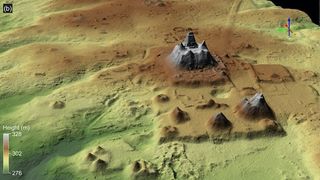Lasers reveal massive, 650-square-mile Maya site hidden beneath Guatemalan rainforest
While conducting an aerial survey of northern Guatemala, researchers detected a sprawling Maya site.

Geologists in northern Guatemala have discovered a massive Maya site that stretches approximately 650 square miles (1,700 square kilometers) and dates to the Middle and Late Preclassic period (roughly 1000 B.C. to 250 B.C.).
The findings were the result of an aerial survey that researchers conducted via airplane using lidar (light detection and ranging), in which lasers are beamed out and the reflected light is used to create aerial imagery of a landscape. The technology is particularly beneficial in areas such as the rainforests of Guatemala's Mirador-Calakmul Karst Basin, where lasers can penetrate the thick tree canopy.
Using data from the scans, the team identified more than 1,000 settlements dotting the region, which were interconnected by 100 miles (160 kilometers) of causeways that the Maya likely traversed on foot. They also detected the remains of several large platforms and pyramids, along with canals and reservoirs used for water collection, according to the study, which was published Dec. 5 in the journal Ancient Mesoamerica.
The lidar data showed "for the first time an area that was integrated politically and economically, and never seen before in other places in the Western Hemisphere," study co-author Carlos Morales-Aguilar, a postdoctoral fellow in the Department of Geography and the Environment at the University of Texas at Austin, told Live Science in an email. "We can now see the entire landscape of the Maya region" in this section of Guatemala, he said.
Related: What's hidden inside the ancient Maya pyramids?
So, what made this region so enticing that the Maya would want to settle there in the first place?
"For the Maya, the Mirador-Calakmul Karst Basin was the 'Goldilocks Zone,'" study co-author Ross Ensley, a geologist with the Institute for Geological Study of the Maya Lowlands in Houston, told Live Science in an email. "The Maya settled in [this region] because it had the right mix of uplands for settlement and lowlands for agriculture. The uplands provided a source for limestone, their primary building material, and dry land to live on. The lowlands are mostly seasonal swamps, or bajos, which provided space for wetland agriculture as well as organic-rich soil for use in terraced agriculture."

Researchers have previously used lidar to scan Maya sites in Guatemala. In 2015, an initiative called the Mirador Basin Project conducted two large-scale surveys of the southern portion of the basin, focusing on the ancient city of El Mirador. That project led to the mapping of 658 square miles (1,703 square km) of this section of the country, according to the study.
"When I generated the first bare-earth models of the ancient city of El Mirador, I was blown away," Morales-Aguilar said. "It was fascinating to observe for the first time the large number of reservoirs, monumental pyramids, terraces, residential areas and small mounds."
Researchers hope lidar technology will help them explore sections of Guatemala that have remained a mystery for centuries.
"Lidar has been revolutionary for archaeology in this area, especially if it's covered in tropical forest where visibility is limited," Marcello Canuto, director of the Middle American Research Institute at Tulane University and an anthropologist who wasn't involved in the study, told Live Science. "While surveying, we tend see a small part of the causeway, but lidar lets us see things that are big and linear. This research lets us see the area for the first time; the fact that we have this data is transformative."
Live Science newsletter
Stay up to date on the latest science news by signing up for our Essentials newsletter.

Jennifer Nalewicki is a Salt Lake City-based journalist whose work has been featured in The New York Times, Smithsonian Magazine, Scientific American, Popular Mechanics and more. She covers several science topics from planet Earth to paleontology and archaeology to health and culture. Prior to freelancing, Jennifer held an Editor role at Time Inc. Jennifer has a bachelor's degree in Journalism from The University of Texas at Austin.
-
HistoryIsALie The ruins in South America predate the Mayans. None of the 'known' South American civilizations had anything to do with the ancient ruins found on that continent, and all of the ruins have existed since before the great flood cataclysms.Reply -
ItIsMe123 ReplyHistoryIsALie said:The ruins in South America predate the Mayans. None of the 'known' South American civilizations had anything to do with the ancient ruins found on that continent, and all of the ruins have existed since before the great flood cataclysms.
What does that have to do with this story? -
LLeeJ Reply
I must have missed the term South America in the article or maybe we were reading entirely different articles. My maps do not show Guatemala in South America and there was no mention of Mayan's in South America. There is a great old Mayan saying which is applicable to your remarks, "One must be cautious in trying to show their IQ."HistoryIsALie said:The ruins in South America predate the Mayans. None of the 'known' South American civilizations had anything to do with the ancient ruins found on that continent, and all of the ruins have existed since before the great flood cataclysms. -
Hartmann352 Yucatán Peninsula in Mexico and Belize in Central Americawere home to the ancient Mayan civilization, which originated in about 2600 b.c.e., rose to prominence in about 300 c.e., and collapsed around 900 c.e. Although often studied as an empire, the Mayan civilization was not a unified society but rather a group of twenty culturally similar, independent states.Reply
The ancient Maya, whose early settlements date back to about 2,000 B.C., lived in present-day southern Mexico and northern Central America. As a civilization, they are recognized for their sophisticated calendar systems and hieroglyphic writing, as well as their achievements in areas such as agriculture and architecture.
Around A.D. 250, the Maya entered what’s now known as the Classic Period, an era in which they built flourishing cities with temples and palaces, and population size peaked. However, by the end of the Classic Period, around A.D. 900, almost all of the major cities in what was then the heart of Maya civilization—the southern lowlands region, in present-day northern Guatemala and neighboring portions of Mexico, Belize and Honduras—had been abandoned.
Mayans created a highly developed culture with systems of writing, calendars, mathematics, astronomy, art, architecture, and religious, political, and military order. Mayans constructed beautiful stone cities and religious temples without the use of metal tools or the wheel, since these tools had not yet been discovered by their culture.
Much about Mayan culture is lost forever. The tropical climate of Mexico did not preserve the tree bark books buried with priests, and the Spanish conquerors and missionaries of the 1500s burned or destroyed the remnants of Mayan culture that they found. Nevertheless, archaeologists, people who study the physical remains of past cultures, continue to reveal new aspects of this ancient civilization through present-day excavations or scientific digs.
However, it was the Inca empire which spanned a large portion of South America by the late 1400s c.e. Although many different cultures prospered in the South American Andes Mountains before 3000 b.c.e., the Incas developed their distinctive culture beginning in 1200 c.e. and by 1471 became the largest empire in South America, reigning over a region that stretched from modern-day Ecuador to Chile. Incas built roads, developed trade, created stone architecture, made beautifully worked gold art and jewelry, became skillful potters, and wove lovely fabrics. Much like the Aztecs, the Incas suffered from the attacks of Spanish conquerors and the spread of smallpox. Spaniard Francisco Pizarro (c. 1475–1541) conquered the Incas in 1532 and the territory soon became a colony of Spain. The last Inca emperor remained in power until 1572, when Spaniards killed him.
While the Mayans, Aztecs, and Incas each had distinct clothing traditions and costumes, many similarities exist. In the broadest terms these cultures wore the same types of clothing styles. But the different ways they decorated their skin, adorned their hair, and patterned their fabric, among other daily habits, made them quite distinct and dissimilar.
The Book of Genesis is part of a familiar tale — the story of Noah's flood. Scholars have known for a long time that the Bible isn't the only place this story is found — in fact, the biblical story is similar to a much older Mesopotamian flood story in the epic of Gilgamesh, the eternally running man.
Scholars usually attribute things like the worldwide occurrence of flood stories to common human experiences and our love of repeating good stories, but recently scientists have started to uncover evidence that Noah's flood may have a basis in some rather astonishing events that took place around the Black Sea some 7,500 years ago, more than two thousand years before the oldest of the Central and South American pre-Colombian civilisations.
Two geologists at Columbia University's Lamont-Doherty Earth Observatory have offered a new theory of what happened next. William Ryan and Walter Pitman, in Noah's Flood (Simon & Schuster), 1997, postulate that as time went on, the world warmed, the glaciers retreated and meltwater from the European glaciers began to flow north into the North Sea, depriving the Black Sea of its main source of replenishment. The level of the Black Sea began to drop, and most of the area around its northern boundary — the area adjacent to present-day Crimea and the Sea of Azov — became dry land. At this point, the level of the Black Sea was several hundred feet below that of the Mediterranean, and the two were separated by the barrier of the Bosporus and the Sea of Marmara, then dry land. This situation, with the world ocean rising while the Black Sea was falling, could not last forever. Eventually, like a bathtub overflowing, the Mediterranean had to pour through into the basin of the Black Sea.
The idea that ocean basins can flood catastrophically during periods of rising sea levels is nothing new in geology. Five million years ago, long before there were any humans around, just such an event occurred. The level of the Atlantic Ocean had dropped, or some tectonic event had occurred, with the result that water could no longer get through, and the Mediterranean gradually shrank down to a desert spotted with a few salty bits of ocean. Subsequently, when either the Atlantic rose again or another geological change took place, ocean water began pouring back into the former sea. The basin filled, and the present-day Mediterranean was created.
See: https://www.encyclopedia.com/fashion/encyclopedias-almanacs-transcripts-and-maps/mayans-aztecs-and-incas
See: https://www.smithsonianmag.com/science-nature/evidence-for-a-flood-102813115/
